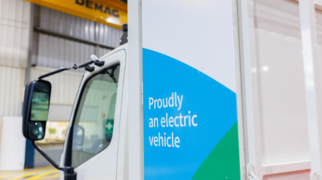The use of liquid fuels in our vehicles, trucks and equipment accounted for 70% of Ventia's emissions in 2021. As Ventia strive to deliver our services in a sustainable and innovative way to reduce our emissions, we are accelerating the pace of our fleet reduction and transition initiatives.
With more than 70 hybrid and electric vehicles now across our fleet we have removed the option to select petrol and diesel passenger light vehicles. Our Wellington City Council contract in New Zealand is our first to boast a full fleet of hybrid vehicles and 32 of the 50 vehicles for our Across Government Facilities Management Arrangement (AGFMA) contract in South Australia are hybrid.
While short-term use of hybrids is essential, we are partnering with fleet providers to provide alternative options, including adopting more EVs where feasible, and pursuing opportunities to transition larger plant and vehicles over time - paving the way towards our goal of zero emissions.
In July 2021, Ventia and global e-mobility technology company, SEA Electric introduced the first custom-built, fully electric road maintenance vehicle into our fleet on the Western Roads Upgrade (WRU) contract in Victoria. As the Services Contractor to Netflow for the 23-year term of the contract, Ventia will maintain 260km of recently upgraded roads between West Melbourne and Werribee.
Instead of sourcing a diesel maintenance truck and adding to greenhouse gas emissions, Ventia and SEA Electric developed a flexible EV that both leads the way for future projects and is purpose-built for maintenance and landscaping. Compared to a diesel truck, the EV reduces CO2-e Scope 1 emissions by 11 tonnes a year.
The EV truck has received innovation recognition from the Infrastructure Sustainability Council (ISC) as a markettransforming opportunity and is one example of how Ventia are addressing a key challenge facing our industry.
The success of the first EV truck in Ventia's fleet paves the way to introduce more EVs in our contracts across Australia and New Zealand. We utilised our experience with the WRU truck when seeking a solution for our incident response fleet.
Ventia provide traffic incident response and maintenance services on motorways and tunnels across Australia for Transurban. This year, we reviewed the opportunity to switch to using electric truck-mounted attenuators (TMAs), which are used to protect the safety of road crews and motorists by providing a cushioned crash barrier to absorb the impact of collisions. TMAs idle for long periods of time when deployed in traffic, so are well suited for electrification.
Having worked with providers to ensure the performance requirements for TMAs can be met, we have now placed our first order for a custom-built, fully electric TMA for delivery in 2022. Modifying a TMA to incorporate a battery for zero emissions operation is so new that there is no 'off-the-shelf' option. This truck will be the first of its kind in Australia.

Ventia is also driving down carbon emissions on its Sydney Roads Asset Performance (SRAP) contract with the addition of two new Tesla electric vehicles.
Ventia provides road maintenance and asset management services to the Parklands zone and Intelligent Transport Systems (ITS) throughout regional NSW for our long-term client, Transport for NSW.
Each Tesla EV will consume 79% less power than a comparable petrol vehicle and 62% less power than a comparable hybrid vehicle. The energy efficient Teslas will be charged from solar power at our Arndell Park depot in Sydney's west, making them operationally carbon neutral.
Currently, the SRAP Maintenance team use standard diesel utilities specially fitted with cameras to undertake inspection runs. The standard Tesla Model 3 comes fitted with onboard camera technology that offers continuous monitoring, and the team are exploring how this could enhance surveillance monitoring to deliver better outcomes for road users.
In addition to light vehicles and trucks we are making progress transitioning other assets, including introducing 14 fully electric mowers in Victoria, and a hybrid excavator in New Zealand in 2022.
